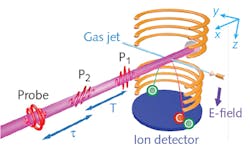Molecular Photonics: Researchers discover new laser-induced molecular echoes
Researchers at East China Normal University (Shanghai, China) and coworkers in France at Laboratoire Interdisciplinaire (Bourgogne), CNRS-Université Bourgogne Franche-Comté (Dijon), Laboratoire Interuniversitaire des Systèmes Atmosphériques (LISA), and Université Paris, and in Israel at the Weizmann Institute of Science (Rehovot) have observed up-to-now unreported molecular echoes in laser-excited molecular gases of carbon dioxide (CO2) and nitrous oxide (N2O).1
Specifically, these new types of molecular alignment echoes—including rotated echoes, fractional echoes of high order, and, most interestingly, imaginary echoes—were visualized in space and time using femtosecond coincident Coulomb explosion imaging techniques.
Visualizing echoes
Sound echoes in mountains are a well-known phenomenon whereby acoustic pulses are mirrored by rocks and reverberate back and forth. Echoes form the basis for methodologies ranging from magnetic-resonance imaging (MRI) to short-wavelength radiation generation in free-electron lasers. The echoes observed by the researchers were variants of molecular-alignment echoes that occur when gas molecules, excited by an ultrashort laser pulse, experience a torque that causes a fleeting alignment of the gas molecules along the polarization axis of the laser.
A pair of time-delayed excitation pulses causes three alignment events: two immediately following each excitation and a third—an echo—that appears with the same delay as that between the two excitation pulses. The echoes originate from kick-induced filamentation of the rotational phase space (a phenomenon known well in the physics of particle accelerators). These echoes were repeated at integer multiples of the pulse delay intervals, and also at its fractions (fractional echoes) and were visualized by a femtosecond coincident Coulomb explosion technique (see figure).
In the experiment, an intense circularly polarized probe pulse is used to fragment the molecules at different delay times around the time of the echo formation. By detecting the ejected fragments from a single molecule, snapshots of the molecular angular distribution were derived.
In this work, various types of molecular alignment echoes were visualized in space and time, including rotated echoes and fractional echoes of high order. Furthermore, imaginary echoes—alignment echoes in the negative time domain (before the excitation pulses)—were also predicted and observed. While "negative" times are obviously not attainable in the real world, the researchers showed that just before the rotational revival time, the system behavior is equivalent to that in negative time, and utilized this realization to demonstrate the imaginary echoes. These molecular echoes may be used for investigating dephasing and dissipation phenomena in dense gases and liquids, similar to the use of spin echoes in different frequency regimes.
"The physics of laser-induced alignment of molecules bears remarkable similarities to modern techniques for laser manipulations over electron beams in accelerator-based light sources," says professor Jian Wu of East China Normal University. "In both cases the goal is to compress the density of particles in certain regions in phase space (angular alignment/orientation and electron bunching along the beam), and this is achieved by folding phase-space with the help of the ultrashort laser pulses. Moreover, molecular alignment echoes are directly related to echo-enabled harmonics generation in free-electron lasers.2 This realization of the analogy between seemingly different areas of physics may be beneficial for both fields."
REFERENCES
1. K. Lin et al., Nat. Photon., 11, 72 (2017); http://dx.doi.org/10.1038/nphoton.2017.10.
2. E. Hemsing et al., Nat. Photon., 10, 512 (2016); http://dx.doi.org/10.1038/nphoton.2016.101.
About the Author

Gail Overton
Senior Editor (2004-2020)
Gail has more than 30 years of engineering, marketing, product management, and editorial experience in the photonics and optical communications industry. Before joining the staff at Laser Focus World in 2004, she held many product management and product marketing roles in the fiber-optics industry, most notably at Hughes (El Segundo, CA), GTE Labs (Waltham, MA), Corning (Corning, NY), Photon Kinetics (Beaverton, OR), and Newport Corporation (Irvine, CA). During her marketing career, Gail published articles in WDM Solutions and Sensors magazine and traveled internationally to conduct product and sales training. Gail received her BS degree in physics, with an emphasis in optics, from San Diego State University in San Diego, CA in May 1986.
